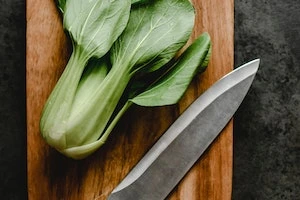Crush on the Crunch! Cruciferous Vegetables
![]() Download as PDF
Download as PDF
Cruciferous Veggies
When planning a lunch or dinner, we all tend to choose from a small group of vegetables – the tried and true that we know well. Some of the most popular vegetables in Canada include potatoes, lettuce, onions, and tomatoes (technically a fruit, but used as a veggie!). These are all great foods and each brings good nutrition to your diet, but there is another family of vegetables that will add variety and impressive health benefits to your plate – the cruciferous vegetables.
This family includes old standards such as cabbage, broccoli, Brussels sprouts and cauliflower, and others that may be less familiar, such as turnip (rutabaga), radish, spinach, daikon, kale, bok choy, and arugula.

What are the benefits of including cruciferous vegetables in your menus?
First, they can lower your risk of cancer. People who eat these veggies regularly, particularly broccoli, have a significantly reduced risk of cervical, lung, bladder and colon cancers, due to the high level of the antioxidant sulforaphane.
When you eat these vegetables, their sulforaphane prompts your body to produce its own antioxidant exzymes, which combat free radicals that cause cellular damage. The high level of Vitamin C in cauliflower also fights heart disease. One cup of cauliflower gives you about 75% of your daily Vitamin C requirement. In this case, the antioxidant levels are higher in raw, rather than cooked, cauliflower.
Cruciferous vegetables also can lower your risk of diabetes (along with overall healthy food and lifestyle choices). Chewed cabbage forms a gel-like substance in the digestive system that slows down the digestion of your meal. That slower digestion helps to control blood sugar levels. Studies have shown a significantly lower incidence of diabetes in people who consumed higher quantities of cruciferous vegetables.
Kale, broccoli and bok choy are all very good sources of calcium. Chop up some kale or bok choy and add them to a stir -fry or soup to bump up your level of calcium for the day. Kale and spinach are also great sources of Vitamin K (potassium), which helps to form and repair bones, and also helps your body form blood clots, in case of wounds.
It’s easy to incorporate these low-calorie vegetables – only 54 calories for a cup of cooked broccoli -into your meals. For instance, finely shred red and/or green cabbage to top your burger instead of lettuce You can add chopped broccoli and cauliflower to your omelette or frittata for a healthy and colourful nutrition boost. Steam these two with a medley of different coloured sweet peppers for an attractive side dish – finish with a bit of reduced-fat butter, a splash of fresh lemon juice, and a grinding of black pepper, and toss to mix the flavours. Finely grate radishes and toss them into a salad for an eye-catching touch of colour.
So explore the world of cruciferous vegetables, and discover new and delicious ways to eat well.